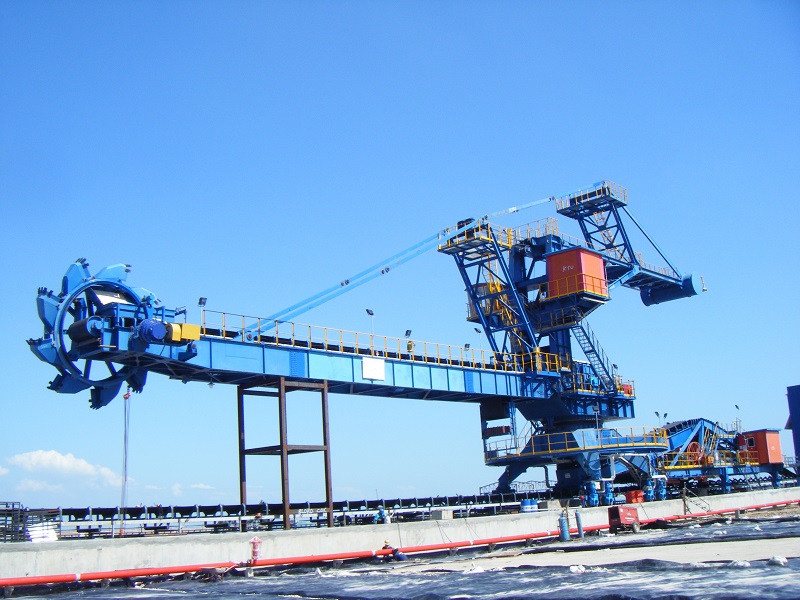How does a bucket wheel excavator work
bucket wheel excavator
Bucket wheel excavator is a common large-scale construction machinery, mainly used for excavation, loading and transportation of earthwork, rock and other materials. It uses a bucket wheel as a tool for digging and loading, and has the advantages of large digging depth, strong loading capacity, and long transportation distance. It has been widely used in mining, construction, water conservancy and other fields.

The working principle of the bucket wheel excavator is to use the rotation of the bucket wheel and the opening and closing of the bucket to complete the work of excavation, loading and transportation. Specifically, the bucket wheel of the bucket wheel excavator is composed of multiple bucket teeth, and the bucket wheel is driven to rotate through the hydraulic system to excavate ground materials onto the bucket wheel. With the rotation of the bucket wheel, the excavated material is transported to the bucket, and the bucket is controlled by the hydraulic system to load the material onto the vehicle or transportation equipment.
The working process of bucket wheel excavator can be divided into the following steps. First, the driver of the bucket wheel excavator moves the machine to the dig site, placing the bucket wheels on the ground. The driver then activates the bucket wheel's hydraulic system through a button or lever on the console, causing the bucket wheel to spin. As the bucket wheel rotates, the teeth excavate ground material onto the bucket wheel. When the bucket wheel is full of material, the driver controls the opening and closing of the bucket through the button or lever on the console to load the material onto the vehicle or transport equipment. Finally, the driver moves the bucket wheel excavator to the next excavation site and continues the work of digging, loading and transporting.
The advantages of Bucket Wheel Stacker Reclaimers are mainly reflected in the following aspects. First of all, it has the characteristics of large digging depth and can dig deep ground materials. Secondly, the bucket wheel excavator has a strong loading capacity, which can load a large amount of materials and improve work efficiency. Thirdly, the bucket wheel excavator has a long transportation distance, and can transport materials to far away places, reducing manpower and time costs. Finally, the operation of the bucket wheel excavator is simple, and the driver only needs to master certain operating skills to complete the work of excavation, loading and transportation.
The application fields of bucket wheel excavators mainly include mining, construction, water conservancy and other fields. In the field of mining, bucket wheel excavators can be used for mining, ore mining, etc., to improve mining efficiency. In the field of construction, bucket wheel excavators can be used for earthwork, stonework and other engineering constructions to improve construction efficiency. In the field of water conservancy, bucket wheel excavators can be used for dredging and dredging to ensure the normal operation of water conservancy facilities.
Generally speaking, the bucket wheel excavator is an efficient, flexible and reliable construction machine, and has become one of the indispensable equipment for modern engineering construction. In the future development, bucket wheel excavators are expected to further improve work efficiency, reduce energy consumption, reduce maintenance costs, and create a safer, more efficient and environmentally friendly working environment for people.
 O'zbek
O'zbek slovenský
slovenský Azərbaycan
Azərbaycan Қазақ
Қазақ Latine
Latine ລາວ
ລາວ български
български नेपाली
नेपाली فارسی
فارسی Javanese
Javanese Українська
Українська Lietuvos
Lietuvos Română
Română Slovenski
Slovenski پښتو
پښتو Punjabi
Punjabi Bosanski
Bosanski Malti
Malti Galego
Galego Afrikaans
Afrikaans Esperanto
Esperanto 简体中文
简体中文 Српски
Српски मराठी
मराठी Ελληνικά
Ελληνικά čeština
čeština Polski
Polski ไทย
ไทย Nederlands
Nederlands Italiano
Italiano Tiếng Việt
Tiếng Việt Deutsch
Deutsch français
français русский
русский Português
Português Español
Español 한국어
한국어 Svenska
Svenska Malay
Malay اردو
اردو norsk
norsk Indonesia
Indonesia عربى
عربى Gaeilge
Gaeilge Türk
Türk Pilipino
Pilipino हिन्दी
हिन्दी Dansk
Dansk বাংলা
বাংলা English
English


The Expanding Role of Long Distance Conveyors in Modern Industrial Applications
In the modern era of industrial automation and large-scale material handling, the Long Distance Conveyor has emerged as a crucial technology for improving efficiency and reducing transportation costs. Designed to move bulk materials over extended distances, these conveyors are now widely applied in mining, cement production, power generation, port logistics, and other heavy industries that require reliable, continuous transport systems.
Read MoreThe Expanding Applications of Rotary Drum Mixers in Modern Industries
In today’s fast-paced industrial environment, the Rotary Drum Mixer has become a vital piece of equipment across various sectors due to its reliability, efficiency, and ability to handle diverse materials. Known for its robust design and uniform mixing performance, this machine plays a key role in industries such as pharmaceuticals, chemicals, food processing, construction, and agriculture.
Read MoreJuli Engineering: A Trusted Supplier of Durable Coal Screw Feeders for Reliable Material Handling
In the fast-evolving industrial sector, efficiency, durability, and reliability are essential in material handling systems. Juli Engineering, a leading Durable Coal Screw Feeder supplier, continues to set industry standards with its high-quality products designed for continuous and precise coal feeding applications. With a reputation for engineering excellence and long-term performance, Juli Engineering provides advanced screw feeder solutions that meet the demanding needs of power plants, mining operations, and industrial production lines.
Read More